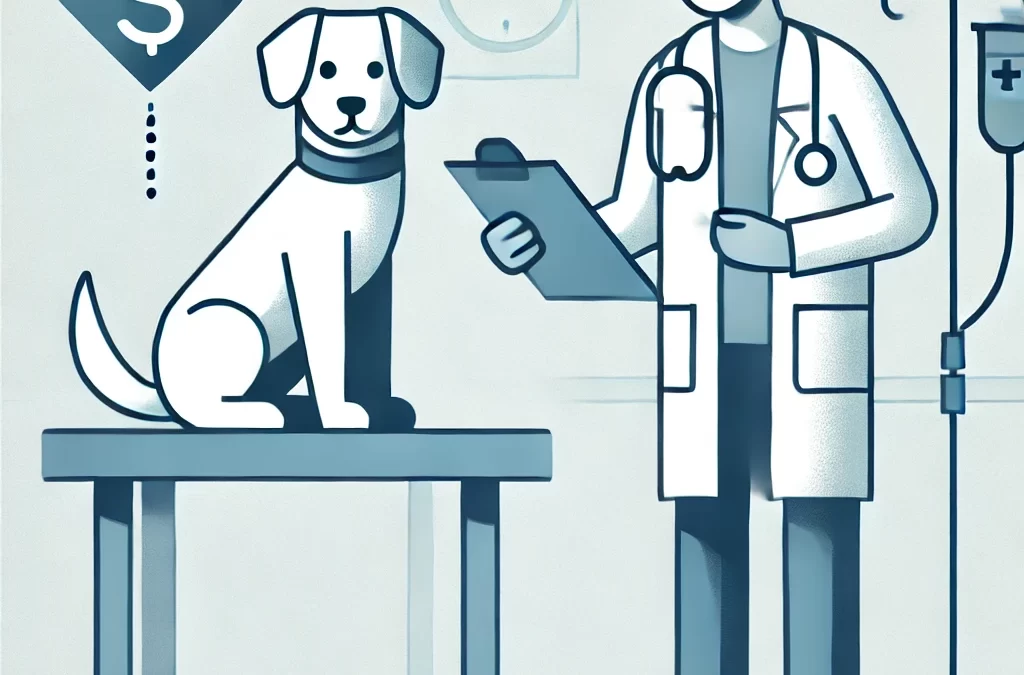
utworzone przez TCMVET | 25 listopada 2024 | Rak i guzy u psów
Mięsak kości, bardzo agresywny nowotwór kości, często wzbudza strach w sercach właścicieli psów. Konwencjonalne metody leczenia, takie jak amputacja i chemioterapia, choć powszechne, mogą być obciążające finansowo i emocjonalnie. Jednak naturalne terapie zyskują na popularności ze względu na ich potencjał poprawy jakości życia, łagodzenia objawów i wspierania procesów gojenia organizmu. Poniżej zagłębiamy się w różnorodne innowacyjne naturalne metody leczenia dostosowane do psiego mięsaka kości.
Zrozumienie kostniakomięsaka u psów
Mięsak kości zazwyczaj atakuje duże i olbrzymie rasy, atakując kończyny. Charakteryzuje się szybkim wzrostem guza i wysokim ryzykiem przerzutów do płuc. Wczesne wykrycie i wielopłaszczyznowe podejście do leczenia mogą znacznie poprawić jakość życia psa.
Naturalne zabiegi wspomagające podróż Twojego psa
1. Ziołowe środki lecznicze na ból
Naturalne leczenie bólu może zmniejszyć zależność od leków, które często mają skutki uboczne. Rozważ te zioła:
- Kadzidłowiec:Ta żywica, znana ze swoich właściwości przeciwzapalnych, zmniejsza obrzęki i poprawia ruchomość.
- Kurkuma (Curcumin):Kurkuma jest silnym środkiem przeciwzapalnym i antyoksydacyjnym, który może łagodzić dolegliwości stawowe, a także została przebadana pod kątem jej działania przeciwnowotworowego.
- Yunnan Baiyao:Chińska formuła ziołowa znana ze swoich właściwości poprawiających krążenie krwi i łagodzących ból, szczególnie w przypadku urazów kości i raka.
2. Strategie dietetyczne wzmacniające odporność
Odżywianie odgrywa kluczową rolę we wspieraniu układu odpornościowego psa podczas leczenia raka. Skup się na:
- Diety wysokobiałkowe:Aby utrzymać masę mięśniową i poziom energii.
- Kwasy tłuszczowe omega-3Substancje te znajdują się w oleju rybim i pomagają łagodzić stany zapalne oraz spowalniać rozwój guza.
- Posiłki o niskiej zawartości węglowodanów i wysokiej zawartości tłuszczu:Komórki nowotworowe żywią się cukrem, dlatego dieta ketogeniczna może ograniczyć rozwój guza.
3. Kannabidiol (CBD) jako wsparcie w leczeniu raka
Olej CBD pochodzący z konopi jest ceniony za swoje właściwości przeciwzapalne i przeciwnowotworowe. Pomaga:
- Zmniejsz ból i lęk.
- Poprawia apetyt i poziom energii.
- Potencjalnie hamują wzrost komórek nowotworowych, jak wykazały nowe badania.
Wybierając olejek CBD, upewnij się, że ma pełne spektrum działania, jest organiczny i nie zawiera THC.
4. Acupuncture and Traditional Chinese Medicine (TCM)
Zabiegi TCM, takie jak akupunktura, mogą uzupełniać inne terapie poprzez:
- Łagodzenie bólu i poprawa krążenia krwi.
- Wzmacnianie funkcji odpornościowych.
- Przywracanie równowagi energetycznej (Qi) ciała.
Formuły ziołowe takie jak: Baituxiao może konkretnie ukierunkować wzrost guza i poprawić ogólne samopoczucie. Zawsze skonsultuj się z weterynarzem doświadczonym w TCM, aby dostosować leczenie do swojego psa.
5. Fizjoterapia i delikatne ćwiczenia
Fizjoterapia stosowana po operacji lub jako część opieki paliatywnej pomaga:
- Utrzymuje ruchomość i zapobiega zanikowi mięśni.
- Popraw nastrój i zaangażowanie umysłowe. Aktywności takie jak pływanie lub kontrolowany spacer mogą być szczególnie skuteczne w przypadku psów z amputacją kończyny.
6. Podejścia homeopatyczne
Niektórzy właściciele zwierząt domowych szukają środków homeopatycznych, takich jak:
- Symphytum: Ten środek, znany jako „zrost kości”, może wspomagać gojenie się kości.
- Lawa Hecla:Stosowany w leczeniu chorób kości, w tym nowotworów i kostniakomięsaków.
Skonsultuj się z lekarzem weterynarii specjalizującym się w homeopatii, aby uzyskać odpowiednie wskazówki i ustalić dawkowanie.
Studium przypadku: Naturalna podróż
Weźmy historię Belli, 9-letniego dog niemieckiego, u którego zdiagnozowano kostniakomięsaka. Po amputacji jej właściciel uzupełnił konwencjonalne leczenie dietą wysokobiałkową, niskowęglowodanową, olejem CBD i ekstraktem z Boswellia. Regularne sesje akupunktury poprawiły mobilność i nastrój Belli. Holistyczne podejście nie tylko wydłużyło jej życie, ale także zapewniło jej komfort i godność.
Wskazówki dla właścicieli psów, którzy chcą poznać naturalne metody leczenia
- Współpracuj z holistycznym lekarzem weterynariiWspółpraca gwarantuje bezpieczeństwo i skuteczność terapii.
- Ściśle monitoruj postęp:Regularne kontrole i badania obrazowe pomagają ocenić skuteczność leczenia.
- Pozostań otwarty:Łączenie metod naturalnych i konwencjonalnych często daje najlepsze efekty.
Znaczenie wsparcia emocjonalnego
Opieka nad psem chorym na raka może być wyczerpująca emocjonalnie. Budowanie sieci wsparcia przyjaciół, rodziny i holistycznych weterynarzy zapewnia, że nie jesteś sam w tej podróży.
Wnioski
Naturalne metody leczenia kostniakomięsaka u psów koncentrują się na poprawie jakości życia, łagodzeniu bólu i wspieraniu układu odpornościowego. Łącząc oparte na dowodach naturalne terapie z tradycyjnymi metodami leczenia, możesz stworzyć plan opieki, który stawia na pierwszym miejscu komfort i dobre samopoczucie Twojego psa. Pamiętaj, że każdy pies jest wyjątkowy, a dostosowane podejście jest kluczem do sukcesu.
Twój czworonożny towarzysz zasługuje na szansę walki — to naturalne.

utworzone przez TCMVET | 24 listopada 2024 | Rak i guzy u psów
Kiedy ukochany zwierzak zostaje zdiagnozowany z rakiem, emocjonalny ciężar dla jego ludzkich towarzyszy jest ogromny. Ale obok bólu serca pojawia się inna przytłaczająca rzeczywistość: koszt leczenia. Leczenie raka u zwierząt domowych może uratować życie, ale często wiąże się z wysoką ceną. Więc jaki jest prawdziwy koszt dania Twojemu futrzanemu przyjacielowi szansy na walkę — i jak mierzymy wartość jego życia w dolarach?
Podział średniego kosztu
Koszt leczenia raka u zwierząt domowych różni się znacząco w zależności od takich czynników, jak rodzaj raka, stadium diagnozy, opcje leczenia i lokalizacja. Oto ogólne zestawienie:
- Diagnostyka:
- Zdjęcia rentgenowskie, USG, biopsje i badania krwi mogą kosztować od $500 i $1,500Zaawansowane obrazowanie, takie jak tomografia komputerowa lub rezonans magnetyczny, może dodać kolejną $1000 do $2500.
- Chirurgia:
- Chirurgiczne usunięcie guza często obejmuje: $1000 do $5000, w zależności od złożoności i lokalizacji.
- Chemioterapia:
- Protokóły chemioterapii mogą kosztować od $3000 i $10000, w zależności od liczby sesji i zastosowanych leków.
- Radioterapia:
- To zaawansowane leczenie może obejmować: $5000 do $15000, co czyni ją jedną z najdroższych opcji.
- Opieka paliatywna:
- Jeśli leczenie lecznicze nie jest możliwe, opieka paliatywna w celu łagodzenia objawów może być nadal kosztowna $500 do $2000.
Łącznie średni koszt leczenia raka u zwierząt domowych może mieścić się w przedziale $5000 i $20000—a czasami nawet wyższe. Te liczby są otrzeźwiające, zwłaszcza gdy porówna się je z budżetem domowym.
Koszt emocjonalny a finansowy
Dla wielu właścicieli zwierząt domowych decyzja o leczeniu raka nie jest tylko kwestią finansową, ale głęboko emocjonalną. Zwierzęta domowe są rodziną, a myśl o tym, że nie zrobimy wszystkiego, co możliwe, aby je uratować, wydaje się nie do zniesienia. Jednak rzeczywistość onkologii weterynaryjnej jest taka, że sukces nie jest gwarantowany, a nawet agresywne metody leczenia mogą przedłużyć życie zwierzęcia jedynie o miesiące lub kilka lat.
- Rozważania emocjonalne:
Wartość czasu uzyskanego dzięki leczeniu — czy to tygodnie, miesiące czy lata — nie może być łatwo oszacowana. Wielu właścicieli zwierząt domowych twierdzi, że nawet kilka dodatkowych miesięcy jakościowego czasu spędzonego ze swoimi pupilami było warte każdego grosza.
- Obciążenie finansowe:
Jednak ciężar finansowy może prowadzić do poczucia winy i stresu, zwłaszcza gdy koszty leczenia kolidują z potrzebami gospodarstwa domowego. To nie do pozazdroszczenia sytuacja: jak powiedzieć nie, gdy stawką jest miłość?
Czy istnieją sposoby na obniżenie kosztów?
Właściciele zwierząt domowych, u których zdiagnozowano raka, powinni wiedzieć, że istnieją sposoby na zarządzanie kosztami leczenia i ich redukcję:
- Ubezpieczenie zwierząt:
Jeśli wykupisz je wcześnie, ubezpieczenie dla zwierząt domowych może pokryć znaczną część kosztów leczenia raka. Jednak schorzenia występujące wcześniej są zazwyczaj wykluczone.
- Organizacje non-profit:
Wiele organizacji zapewnia pomoc finansową na opiekę medyczną nad zwierzętami domowymi, szczególnie w przypadku leczenia raka.
- Opcje holistyczne i paliatywne:
W przypadku zwierząt domowych ze złym rokowaniem holistyczne metody leczenia, takie jak olejek CBD, akupunktura lub naturalne suplementy, mogą okazać się tańszym sposobem na poprawę jakości życia.
- Badania kliniczne:
Niektóre placówki weterynaryjne prowadzą badania kliniczne nad nowymi metodami leczenia raka i często pokrywają część kosztów.
- Omów opcje ze swoim lekarzem weterynarii:
Wielu weterynarzy jest gotowych współpracować z właścicielami zwierząt domowych w celu opracowania realistycznego i przystępnego cenowo planu leczenia. Niektóre kliniki oferują również plany płatności.
Czy warto?
Pytanie, czy koszt leczenia raka u zwierząt domowych jest „warty zachodu”, jest głęboko osobiste. Dla niektórych odpowiedź brzmi: zdecydowanie tak — ponieważ żadna cena nie jest zbyt wysoka dla miłości. Dla innych decyzja o zaniechaniu leczenia nie jest oznaką porażki, ale aktem współczucia, stawiającym wygodę i godność zwierzęcia na pierwszym miejscu ponad przedłużanie jego życia za wszelką cenę.
Nowe zdefiniowanie wartości w opiece nad zwierzętami domowymi cierpiącymi na raka
Ostatecznie średni koszt leczenia raka u zwierząt domowych to nie tylko statystyka finansowa, ale odzwierciedlenie tego, jak daleko posuniemy się dla naszych futrzanych towarzyszy. Podróż ta dotyczy zarówno nadziei, miłości i odporności, jak i pieniędzy. Niezależnie od tego, czy zdecydujesz się na leczenie, czy opiekę paliatywną, decyzja powinna uszanować więź, którą dzielisz ze swoim zwierzęciem i jakość jego życia.
W miarę rozwoju onkologii weterynaryjnej być może pewnego dnia nie będziemy musieli mierzyć naszej miłości dolarami. Do tego czasu robimy, co możemy — całym sercem i portfelem — aby dać naszym pupilom życie, na jakie zasługują.

utworzone przez TCMVET | 24 listopada 2024 | Rak i guzy u psów
Stosowanie naturalnych środków zaradczych w leczeniu raka u psów zyskało znaczną uwagę w ostatnich latach, a bylica wyłania się jako intrygujący kandydat. Znany naukowo jako Bylica piołunowa, bylica ma długą historię w medycynie tradycyjnej, ale jej potencjalne korzyści w leczeniu raka, zwłaszcza u psów, dopiero niedawno wzbudziły zainteresowanie zarówno wśród badaczy, jak i właścicieli zwierząt domowych. Czy to starożytne zioło może być obiecujące w walce z rakiem u psów?
Czym jest bylica?
Bylica to wieloletnia roślina zielna słynąca z gorzkiego smaku i właściwości leczniczych. Tradycyjnie stosowana w leczeniu problemów trawiennych i infekcji pasożytniczych, bylica jest również znana ze swoich potencjalnych właściwości przeciwzapalnych, przeciwdrobnoustrojowych, a nawet przeciwnowotworowych. Jej główny związek aktywny, artemizyna, był szeroko badany pod kątem skuteczności w walce z niektórymi typami komórek nowotworowych u ludzi.
Nauka o piołunu i raku
Badania sugerują, że artemizyna może działać poprzez celowanie w komórki rakowe bogate w żelazo, minerał, który komórki rakowe często gromadzą, aby wspierać swój szybki wzrost. Artemizyna wchodzi w interakcję z tym żelazem, wytwarzając wolne rodniki, które mogą niszczyć komórki rakowe, pozostawiając zdrowe komórki stosunkowo nieuszkodzone. Podczas gdy większość badań skupiała się na zastosowaniach u ludzi, zasady te wzbudziły zainteresowanie onkologii weterynaryjnej.
Bylica i rak u psów: potencjalne powiązanie
U psów zdiagnozowanych z nowotworem, takim jak kostniakomięsak, chłoniak lub guzy komórek tucznych, często stosuje się kosztowne i inwazyjne leczenie, takie jak operacja, chemioterapia lub radioterapia. Wielu właścicieli zwierząt domowych zwraca się ku terapiom uzupełniającym, aby poprawić jakość życia swoich psów, a piołun jest coraz częściej badany w tym celu. Anegdotyczne dowody od holistycznych weterynarzy i właścicieli zwierząt domowych sugerują, że piołun może pomóc zmniejszyć wzrost guza, złagodzić stan zapalny i zwiększyć ogólną witalność.
Jak piołun może pomóc psom chorym na raka
- Właściwości przeciwnowotworowe:Artemizynina zawarta w bylicy może atakować komórki rakowe i je zabijać, potencjalnie spowalniając postęp choroby.
- Działanie przeciwzapalnePrzeciwzapalne właściwości piołunu mogą łagodzić dolegliwości i poprawiać sprawność ruchową u psów z guzami lub przerzutami.
- Wsparcie immunologiczneUważa się, że piołun wspomaga układ odpornościowy, co jest niezwykle ważne dla psów zmagających się z rakiem.
Środki ostrożności i uwagi
Pomimo swojego potencjału, piołun nie jest pozbawiony ryzyka. Wysokie dawki mogą być toksyczne, powodując skutki uboczne, takie jak wymioty, biegunka lub problemy neurologiczne. Ponadto nie wszystkie psy nadają się do terapii na bazie piołunu. Przed wprowadzeniem piołunu do schematu leczenia psa konieczna jest konsultacja z holistycznym lub integracyjnym lekarzem weterynarii.
Realistyczne oczekiwania: narzędzie uzupełniające
Ważne jest, aby pamiętać, że piołun nie jest lekarstwem na raka, ale potencjalną terapią uzupełniającą. Jego korzyści mogą się różnić w zależności od rodzaju i stadium raka, a także ogólnego stanu zdrowia psa. Łączenie piołunu z konwencjonalnymi metodami leczenia lub innymi naturalnymi środkami, takimi jak olej CBD lub grzyby lecznicze, może zwiększyć jego skuteczność, oferując jednocześnie wieloaspektowe podejście do leczenia raka.
Przyszłość badań nad byliną w medycynie weterynaryjnej
Brak obszernych badań klinicznych nad byliną w leczeniu raka u psów podkreśla potrzebę dalszych badań. Jednak wczesne odkrycia i anegdotyczne sukcesy wskazują na jej potencjał jako części szerszej strategii naturalnego leczenia raka. Dzięki większej naukowej walidacji bylica mogłaby stać się podstawą holistycznej opieki weterynaryjnej.
Wnioski
Dla właścicieli zwierząt domowych poszukujących alternatywnych opcji poprawy jakości życia swojego psa, piołun stanowi fascynującą możliwość. Jego potencjalne właściwości przeciwnowotworowe i wspomagające sprawiają, że jest godnym kandydatem do rozważenia w leczeniu raka u psów. Jednak, jak w przypadku każdego leczenia, kluczowe są ostrożność i profesjonalne wskazówki. Jeśli rozważasz zastosowanie piołunu dla swojego psa, pamiętaj: droga do zdrowia często polega na połączeniu najlepszych elementów podejścia tradycyjnego i nowoczesnego.
Bylica i rak u psów — starożytne zioło na współczesne wyzwanie. Czy to może być naturalne rozwiązanie, którego potrzebuje Twój futrzany przyjaciel? Tylko czas i badania pokażą.

utworzone przez TCMVET | 23 listopada 2024 | Rak i guzy u psów
Guzy komórek tucznych (MCT) są jednym z najczęstszych rodzajów nowotworów u psów, często objawiającym się jako guzy na skórze. Podczas gdy niektóre psy przeżywają dzięki terminowemu leczeniu, inne ulegają tej chorobie. Proces, w którym guzy komórek tucznych prowadzą do śmierci, może być zarówno złożony, jak i stopniowy, obejmując kaskadę zaburzeń biologicznych, które wpływają na całe ciało psa. W tym artykule zagłębiamy się w niedostatecznie zbadaną historię tego, jak guzy komórek tucznych mogą prowadzić do śmiertelnych skutków.
Biologiczne pole bitwy: zrozumienie guzów komórek tucznych
Komórki tuczne są częścią układu odpornościowego, odpowiedzialnego za uwalnianie histaminy i innych substancji chemicznych w celu zwalczania alergenów i infekcji. Jednak gdy komórki te stają się nowotworowe, sieją spustoszenie w organizmie.
Guzy komórek tucznych często stają się niebezpieczne nie z powodu samego guza pierwotnego, ale z powodu ich skutków systemowych. Skutki te mogą wywołać zagrażające życiu powikłania w sposób, który może zaskoczyć wielu właścicieli psów.
Cisi zabójcy: mechanizmy powodujące zgony
1. Nadmiar histaminy: wewnętrzna burza
Jednym z najbardziej podstępnych skutków guzów komórek tucznych jest nadmierne uwalnianie histaminy i innych mediatorów chemicznych. Może to prowadzić do:
- Wrzody żołądka: Histamina stymuluje produkcję kwasu w żołądku, co może powodować wrzody. Wrzody te mogą krwawić, prowadząc do ciężkiej anemii lub zagrażających życiu krwotoków.
- Wstrząs: Nagłe uwolnienie histaminy może skutkować ogólnoustrojowym stanem zapalnym i niebezpiecznym spadkiem ciśnienia krwi, co może potencjalnie doprowadzić do wstrząsu anafilaktycznego.
2. Niewydolność narządów: efekt domina
Gdy guzy komórek tucznych dają przerzuty, atakują ważne organy, takie jak wątroba, śledziona i szpik kostny. Może to skutkować:
- Dysfunkcja wątroby: Niezdolność wątroby do przetwarzania toksyn może prowadzić do żółtaczki i zatrucia ogólnoustrojowego.
- Supresja szpiku kostnego: Jeśli komórki tuczne przedostaną się do szpiku kostnego, produkcja czerwonych i białych krwinek zostaje zaburzona, co powoduje anemię i osłabienie układu odpornościowego.
3. Kacheksja: zespół wyniszczenia nowotworowego
Kacheksja, czyli wyniszczenie związane z rakiem, jest częstą przyczyną śmierci psów z zaawansowanymi guzami komórek tucznych. Guz zmienia metabolizm psa, powodując:
- Utrata masy mięśniowej: Mimo jedzenia psy tracą masę mięśniową i siłę.
- Zmęczenie: Ten wyniszczający stan może sprawić, że nawet proste czynności staną się nie do zniesienia.
4. Niekontrolowany wzrost guza: Zniszczenie lokalne
W niektórych przypadkach sam guz rośnie agresywnie, naciekając otaczające tkanki. Może to powodować:
- Otwarte rany: Owrzodzenia guzów mogą ulec zakażeniu, co może prowadzić do sepsy.
- Ból i problemy z poruszaniem się: Guzy w pobliżu stawów lub ważnych struktur mogą powodować okropny ból i ograniczać ruchomość.
Poza biologią: zmiany emocjonalne i behawioralne
Psy cierpiące na guzy komórek tucznych mogą wykazywać zmiany w zachowaniu z powodu bólu, dyskomfortu lub choroby układowej. Objawy takie jak niepokój, agresja lub wycofanie są często pomijane, ale wskazują na powagę ich cierpienia.
Przełamanie milczenia: znaczenie wczesnej interwencji
Chociaż guzy komórek tucznych mogą być śmiertelne, ich postęp nie zawsze jest nieunikniony. Wczesne wykrycie i leczenie może drastycznie zmienić wynik. Oto kilka proaktywnych kroków:
- Częste wizyty u weterynarza: Regularne kontrole zwiększają szansę wykrycia guzów we wczesnym stadium.
- Biopsja wszystkich guzów: Nawet guzy wyglądające łagodnie mogą być guzami komórek tucznych.
- Terapie skojarzone: Najczęstszymi metodami leczenia są zabieg chirurgiczny, radioterapia i chemioterapia, ale pojawiają się również nowsze metody, takie jak immunoterapia.
Nowe granice: holistyczna opieka nad MCT
Oprócz konwencjonalnych metod leczenia, zastosowanie holistycznego podejścia może poprawić jakość życia psa:
- Zmiany w diecie: Dieta przeciwzapalna zawierająca kwasy tłuszczowe omega-3 może korzystnie wpływać na ogólny stan zdrowia.
- Suplementy ziołowe: Składniki takie jak kurkuma i boswellia mogą pomóc w zmniejszeniu stanu zapalnego.
- Redukcja stresu: Przewlekły stres może zaostrzać objawy raka. Pomocne może okazać się uspokajające otoczenie i delikatne ćwiczenia.
Kiedy nadszedł czas, aby powiedzieć „do widzenia”?
Decyzja o eutanazji psa z guzami komórek tucznych jest jedną z najtrudniejszych decyzji, jaką może podjąć właściciel zwierzęcia. Narzędzia takie jak Quality of Life Scale (QoL) mogą pomóc w podjęciu tej decyzji, skupiając się na poziomie bólu, apetycie i zdolności psa do cieszenia się codziennymi czynnościami.
Wnioski: Zrozumienie, które daje siłę
Guzy komórek tucznych to coś więcej niż tylko guzy — to systemowe zagrożenia, które mogą po cichu i stopniowo przytłoczyć ciało psa. Rozumiejąc mechanizmy stojące za ich śmiertelnością, właściciele zwierząt domowych i weterynarze mogą podejmować świadome decyzje, aby złagodzić cierpienie i poprawić wyniki. Umocnieni wiedzą, możemy zapewnić, że każda chwila z naszymi ukochanymi zwierzętami będzie tak bezbolesna i satysfakcjonująca, jak to tylko możliwe.

utworzone przez TCMVET | 23 listopada 2024 | Rak i guzy u psów
Kiedy nasi futrzani przyjaciele stają w obliczu diagnozy raka, radzenie sobie z bólem staje się jedną z najpilniejszych kwestii. Ból wpływa nie tylko na jakość ich życia, ale także na ich chęć jedzenia, zabawy i interakcji. Tradycyjne metody łagodzenia bólu, takie jak leki, często wiążą się ze skutkami ubocznymi, które mogą sprawić, że właściciele zwierząt poczują się skonfliktowani. Ale co, jeśli spojrzymy poza konwencjonalne i zbadamy przełomowe, holistyczne podejścia do leczenia bólu?
Zrozumienie bólu u psów chorych na raka
Ból u psów z rakiem jest często wieloaspektowy. Guzy mogą naciskać na nerwy, naciekać tkanki lub powodować stany zapalne, prowadząc do ostrego lub przewlekłego dyskomfortu. Zrozumienie natury tego bólu jest kluczem do wyboru właściwej metody łagodzenia bólu.
Tradycyjne opcje, takie jak NLPZ lub opioidy, mają swoje miejsce, ale mogą wiązać się z ryzykiem, takim jak rozstrój żołądka, obciążenie wątroby lub uzależnienie. Czas pomyśleć nieszablonowo i wyposażyć właścicieli zwierząt domowych w alternatywy, które nie tylko łagodzą ból, ale także wspierają ogólny stan zdrowia.
Holistyczne podejście do łagodzenia bólu
1. Akupunktura i akupresura
Akupunktura, której korzenie sięgają starożytnej medycyny chińskiej, zyskała popularność wśród weterynarzy na całym świecie. Poprzez stymulację określonych punktów na ciele, akupunktura pomaga uwalniać endorfiny — naturalne środki przeciwbólowe organizmu — i poprawia przepływ krwi do dotkniętych obszarów.
- Dlaczego jest skuteczny: Badania pokazują, że akupunktura może łagodzić ból i stan zapalny, co czyni ją skuteczną opcją w przypadku psów doświadczających dyskomfortu związanego z rakiem.
2. Ziołowe środki przeciwbólowe
Niektóre ziołowe środki lecznicze wykazały obiecujące działanie w zmniejszaniu stanu zapalnego i bólu. Składniki takie jak Chuanxiong (lubczyk syczuański), kurkuma i kadzidło mają naturalne właściwości przeciwzapalne.
- Jak z nich korzystać: Można je stosować w postaci suplementów lub herbatek (pod nadzorem lekarza weterynarii), aby zmniejszyć zależność od tradycyjnych środków farmaceutycznych.
3. Olej konopny o pełnym spektrum
CBD, pozyskiwane z konopi, stało się ulubionym środkiem wśród właścicieli zwierząt domowych ze względu na jego podwójną zdolność do radzenia sobie z bólem i lękiem. Oleje o pełnym spektrum zawierają dodatkowe kannabinoidy i terpeny, które działają synergicznie, oferując jeszcze większą ulgę.
- Co go wyróżnia: CBD oddziałuje na układ endokannabinoidowy organizmu, łagodząc stany zapalne i ból bez psychoaktywnych efektów THC.
4. Terapia zimnym laserem
Terapia zimnym laserem to nieinwazyjny zabieg, który wykorzystuje światło do stymulacji regeneracji komórek i zmniejszenia stanu zapalnego. Ta technika jest bezbolesna i może znacznie poprawić mobilność i komfort.
- Idealny dla: Psy cierpiące na bóle stawów lub guzy kończyn lub pleców.
5. Dieta jako sposób na radzenie sobie z bólem
Dieta bogata w składniki odżywcze i przeciwzapalna może być przełomem dla psów z rakiem. Produkty bogate w kwasy tłuszczowe omega-3 (znajdujące się w oleju rybim) i przeciwutleniacze mogą pomóc zmniejszyć stan zapalny i ból w organizmie.
- Przepis do wypróbowania: Połączenie gotowanego chudego mięsa, zmiksowanych warzyw, np. marchwi i brokułów, oraz odrobiny kurkumy lub imbiru może być zarówno pożywne, jak i lecznicze.
Komponent emocjonalny w leczeniu bólu
Ból nie jest tylko fizyczny — ma on również emocjonalny wpływ. Psy często stają się wycofane lub drażliwe, gdy odczuwają ból. Zapewnienie im środowiska wolnego od stresu, mnóstwa czułości i stymulacji umysłowej może mieć ogromne znaczenie.
Spróbuj tego: Wprowadź terapię masażu do rutyny swojego psa. Delikatne głaskanie i nacisk mogą pomóc rozluźnić napięte mięśnie i poprawić krążenie, działając jednocześnie jako aktywność wzmacniająca więzi.
Spojrzenie w przyszłość: medycyna regeneracyjna
Ekscytujące postępy w medycynie regeneracyjnej, takie jak terapia komórkami macierzystymi, torują drogę innowacyjnemu łagodzeniu bólu nowotworowego u psów. Komórki macierzyste mogą naprawiać uszkodzone tkanki i zmniejszać stan zapalny, dając nadzieję na schorzenia wcześniej uznawane za nieuleczalne.
Tworzenie kompleksowego planu leczenia bólu
Uśmierzanie bólu nowotworowego u psa nie polega na wyborze jednej metody — chodzi o opracowanie spersonalizowanego planu. Współpracuj ściśle ze swoim lekarzem weterynarii, aby połączyć najlepsze tradycyjne i alternatywne terapie.
Przykładowy plan:
- Poranek: Olejek CBD do śniadania
- Popołudnie: sesja akupunktury lub terapii zimnym laserem
- Wieczór: Suplement ziołowy z posiłkiem bogatym w kwasy omega
Kiedy powiedzieć „do widzenia”
Leczenie bólu nie dotyczy tylko psa — dotyczy również właściciela zwierzęcia. Wiedza o tym, kiedy puścić, jest jedną z najtrudniejszych decyzji, ale czasami jest to najbardziej kochający wybór. Monitorowanie jakości życia psa za pomocą narzędzi takich jak Skala HHHHHMM (Ból, głód, nawodnienie, higiena, szczęście, mobilność i więcej dobrych dni niż złych) mogą pomóc w podjęciu decyzji.
Wnioski: łagodzenie bólu to podróż, a nie cel podróży
Radzenie sobie z bólem nowotworowym u psów wymaga kreatywności, współczucia i chęci eksplorowania niekonwencjonalnych opcji. Od akupunktury po zmiany w diecie, każdy mały krok, który podejmiesz w kierunku złagodzenia bólu, może poprawić jakość życia Twojego psa. Jako właściciele zwierząt domowych, naszym największym darem dla naszych psów jest zapewnienie, że ich ostatni rozdział będzie wypełniony jak największą ilością komfortu i miłości.





